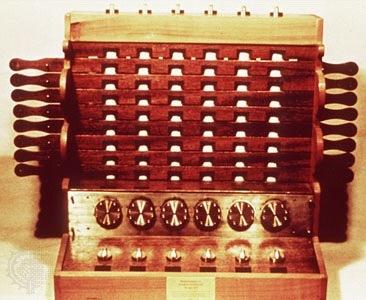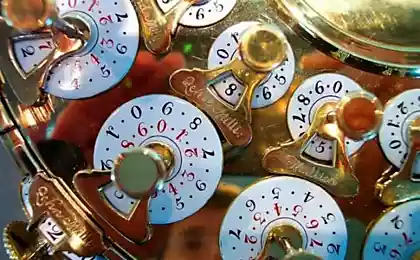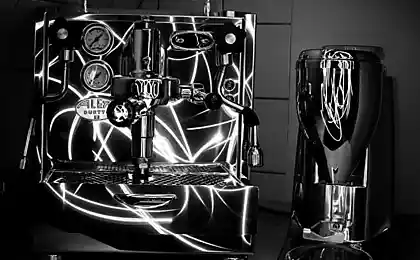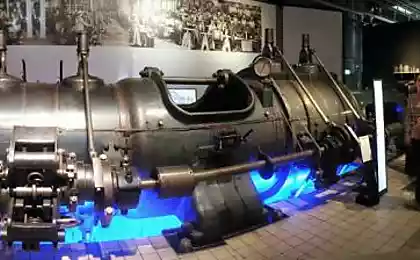The world's first calculating device - the car Schickard

The discovery of this fact Gummer made almost by accident. When he worked in the library of Stuttgart, then I stumbled upon a mysterious sketch photocopy of a counting device. And as before I am seen anything like it, was very interested in the unknown sketch. Having completed a number of studies Gammer has found that found sketch - is the lack of an annex to the letter of the University of Tubingen professor Wilhelm Schickard, addressed to his colleague, mathematician Johannes Kepler. In his letter Schickard described in detail the counting machine and referring to FIG.

copy of the sketch i>
A bit of history
Wilhelm Schickard was born on 22 April 1592 in the town of Herrenberg (Germany). He was extremely talented and already in 17 years received a master's degree in the University of Tübingen, and two years later became a Bachelor of Science. He gained worldwide fame thanks to their achievements in the sciences: astronomy, mathematics and vostokovedstve (Professor of the Department of Oriental Languages at the University of Tübingen). Also, Schickard created the first calculating machine.

Wilhelm Schickard (1592-1635) i>
Since 1617 Schickard began teaching Oriental languages at Tubingen University. There he became acquainted with Kepler, who appreciated the outstanding abilities of a young scientist, and advised him to do mathematics. Schickard followed the advice in his new role and has achieved considerable success. In 1631 he became professor of mathematics and astronomy at the University of Tübingen.
Schickard was a pioneer in other areas. As such - in astronomy. The scientist is constantly evolving, he corresponded with many German, French, Italian and Dutch scientists on matters relating to astronomy. He created the first mechanical planetarium that clearly showed the position of the Sun, Earth and Moon according to the Copernican system. In addition, the meteors observed from different points to determine their trajectory.

Latitude interests Schickard really deserves respect. He was an experienced mechanic, cartographer, engraver on wood and metal, carried out astronomical observations, he wrote treatises on Semitic languages, astronomy, mathematics, optics and meteorology. Scientific research has achieved outstanding success and was truly a genius inventor. But it was powerless before the cholera epidemic. This merciless disease XVII century in 1635 took the lives Schickard and his family. Proceedings of the scientist at a time have been forgotten because of the Thirty Years' War.
machine Schickard - the beginning of XVII century
In a letter to Kepler (from Sept. 20, 1623) reported that Schickard implemented mechanically all that Kepler did algebraically - namely, designed a machine that automatically perform addition, subtraction, multiplication and division. Schickard wrote that Kepler was pleasantly surprised when he saw the device itself collects and transfers left a dozen or a hundred numbers and how it takes that to keep in mind when subtracting.

The invention, which became the first adding machine, was created in 1623. Schickard invented and developed a model of a six-digit mechanical computing device to perform simple mathematical functions, such as - to add and subtract numbers. Not for nothing called him "the clock for the count." The machine Schickard contain summing and multiplying devices, as well as a mechanism for recording intermediate results.
From a letter to Kepler:
... aah - is the upper ends of the vertical cylinders on their side surfaces coated multiplication tables; if necessary, the figures in these tables can be seen in the windows bbb sliding bars. It drives ddd mounted inside the car wheel with ten teeth, each of which is then meshed with his own kind, if any right wheel turns ten times, whatever is left of the wheel makes one rotation, or if the first of these wheels make 100 revolutions third from left wheel rotates once. To gears rotate in the same direction, it is necessary to have intermediate wheel ... blockquote>

Johannes Kepler (1571-1630) i>
A more detailed description helps to get an idea of the invention. The first block in the form of six-bit adder machines are compound gears. Each axis is aligned on the pinion with ten teeth and supporting single-toothed wheel - finger. Finger served to transfer the unit to the next digit, that is, to turn the gear on the tenth of the total turnover, after the previous discharge gear will make a turn. When subtracting the gear required to rotate in the opposite direction. Monitor progress of computation can be with special windows where the numbers appear. For multiplication device was used, the main part of which is six axes with "Screw" on their multiplication tables. Subtraction was performed by rotating the setting wheel in the opposite direction, as the mechanism for the transfer of tens was reversible.

In fact, the car Schickard was pretty simple. For example, to find out what is the product of 296 x 73, you need to install the cylinder in a position that will bring in the top row of windows the first factor: 000296. The product 296 x 3 out, if you open the windows of the third row and sum figures seen as the method lattice . Further, just as the seventh series of open windows, giving the product 7 x 296 to which is attributed to 0. And the glory will only add up to the results of an adder. All the result is ready.
The question remains unresolved - whether collected real working model of the machine during the life of a scientist? On this point the data is very small. The letters Schickard all to the same Kepler refers to "almost ready" copy devices, which burned down in a fire. He was in the development of the mechanic Wilhelm Pfister. It has collected a second model of the machine - is not known. Most likely, no one except Schickard and Pfister have not seen the finished and operating the device. In any case, evidence of performance has not been preserved.

But what exactly - long car Schickard it remained known only to a narrow circle of confidants. And, the present invention could not have an impact on the subsequent development of mechanization account. Who knows, maybe with the help of this project, the progress of computing devices could accelerate. But anyway, the name of the German scientist Wilhelm Schickard is on a par with the great minds inventors counting devices XVII-XIX centuries. Such as Blaise Pascal, Gottfried Wilhelm Leibniz, Charles Babbage, Pafnuty Chebyshev, Herman Hollerith and others.

the prototype of a modern car Schickard i>
Based on materials found Gammer employees Tubingen University in the early 1960s created a working model of the car Schickard. The operations of addition and subtraction carried it mechanically, but multiplication and division - with elements of mechanization. The prototype of the invention is owned by the university.
The evolution in computing technology - the process is quite uneven, which comes from irregular periods to periods of recession the fall. The results achieved are used in practice and every new step brings the process of evolution of computing to a new and higher level.
Source: geektimes.ru/company/ua-hosting/blog/266102/



























